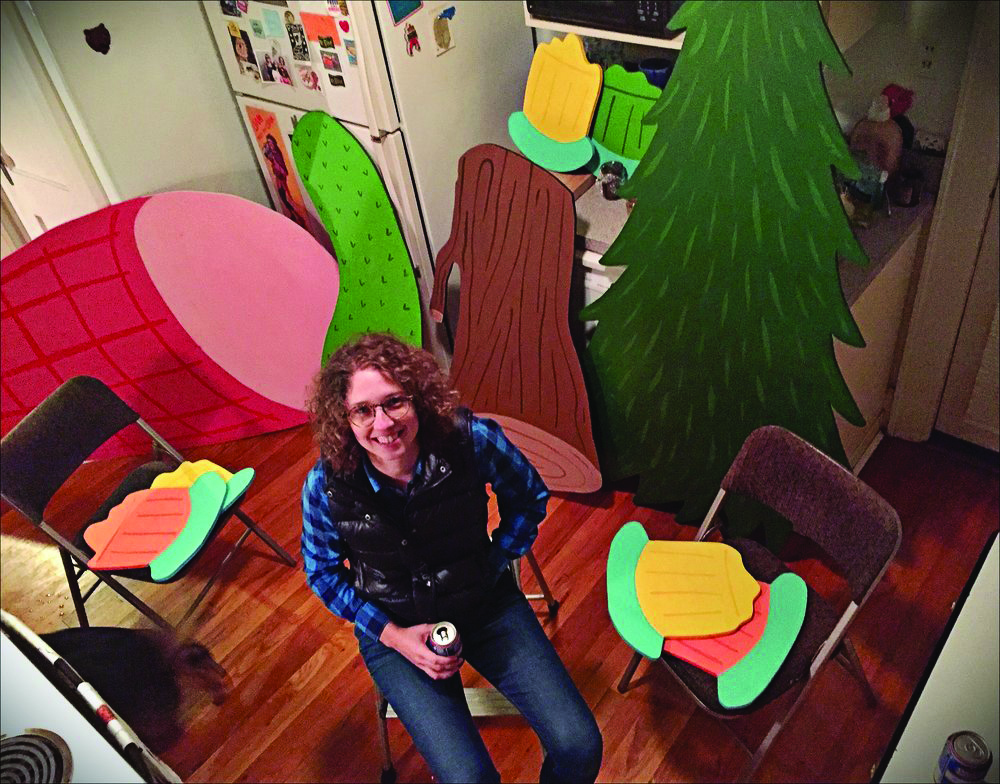ROAD SIDES POP-UP
Saturday, Nov. 2, 5–7 p.m.
Parker and Otis, 112 S. Duke St., Durham
parkerandotis.com

In the heart of Smithfield sits a twenty-five-foot tall, royal-blue building shaped like a snow cone. Hills of Snow was built, aptly, by the Hill family in 1984, when the folklorist Emily Wallace was two; it would become a formative summer destination.
“Anybody who knows me knows that I’m obsessed with it,” she says. “I think in part it’s because Smithfield was a rural community, and we didn’t have an art museum in town, or even an art gallery, but we had this snow cone stand, which, to me, showed what was creatively possible.”
This attention to meaning and creativity drives Wallace’s debut Road Sides, a “glovebox essential” that takes readers on an illustrated A–Z trip through roadside eating in the American South. The book traverses Nashville’s hot chicken, trails along the bootleg highways of Western North Carolina, and makes a stop at Georgia’s Waffle House museum.
We live in the golden age of niche tourism, but Wallace—who received her degree at UNC-Chapel Hill and works as deputy editor and art director at Southern Cultures—puts her stock more in the whys and hows of the way we eat, travel, and work. As with Hills Snow Cones, the emphasis is not just on what is being served, but what it says about us.
The INDY spoke with Wallace last week about her book—and what she learned writing it. This conversation has been edited for length and clarity.
INDY: When did you start working on Road Sides?
EMILY WALLACE: About three years ago. I’d been thinking I’d do something about the road or road food and the South, and then I bought this book called Quodlibet, an illustrated book all about the letter Q. It has little Q word definitions and wacky illustrations. When I found that, I got the idea that I could structure it A to Z, with unexpected definitions and illustrations played off that.
Tell me about the letter K.
K was surprisingly challenging to come up with a concept to pair with it. I started with kudzu, which I thought was a little bit of a throwaway. But it turns out, it has a history alongside the road—it was planted to soak up loose soil when they were cutting in highways. I met with a woman named Edith Edwards in Rutherfordton who started a farm with her husband, Henry—a cow farm. She does all kinds of things; Edith is in her nineties now. She deep-fries kudzu leaves, she bakes them into quiches, she uses the blossoms to make teas and jellies.
What does kudzu taste like?
I can’t say I recall the taste in the quiche. In the jelly, it’s a little apple-like.
You envision this book as a why for road-trip food instead of a where. Can you say more about that?
I envisioned it more as a companion to the experience of eating on the road rather than as a guide to the best spots. There are plenty of fantastic places featured. But the emphasis is really on the backstory—why we have meat-and-three restaurants, or giant food-shaped buildings, or drive-thru windows.
Your master’s thesis is on pimento cheese. What story do you feel that it tells about the South?
When I was in graduate school, I took a documentary food writing class at the Center for Documentary Studies, where we were tasked with following a person or place in the food industry. I’d just moved back to North Carolina from Chicago, where you couldn’t find pimento cheese at the time. And suddenly surrounded by pimento cheese again—at the grocery store and at my grandmother’s house—it dawned on me that I didn’t know anything about the stuff. So I documented a pimento cheese factory in Burlington called Star Foods and fell down a pimento cheese rabbit hole.
A lot of the small pimento cheese and sandwich-spread companies had a close history with the Piedmont’s textile mills. They made spreads that were carried to work in brown paper sacks or that were wheeled through the factories on wagons that sold sandwiches to workers who had to eat at their stations as they found time.
You can now find pimento cheese all over. It’s often used as shorthand for Southern, presented as something cute.
What I like about pimento cheese, though, is that, while it is cute, it’s also substantive. Pimento cheese has a long working-class history, feeding workers in textile mills and on factory lines.
And it looks good in its Sunday best, at weddings, funerals, and other celebrations.
Contact associate arts and culture editor Sarah Edwards at sedwards@indyweek.com.
Support independent local journalism. Join the INDY Press Club to help us keep fearless watchdog reporting and essential arts and culture coverage viable in the Triangle.


